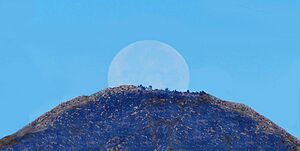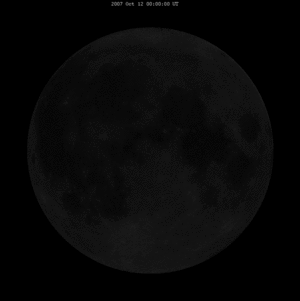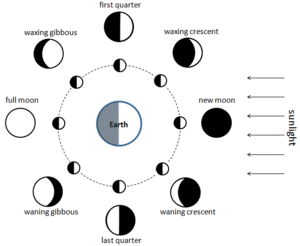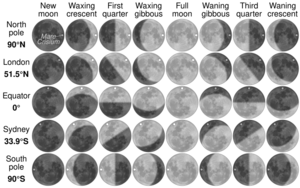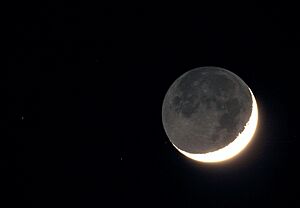Lunar phase facts for kids
A lunar phase or Moon phase is how the Moon looks to us from Earth. It's about how much of the Moon's sunlit side we can see. The Moon always shows us the same side because it's locked in its orbit with Earth.
There are eight main phases of the Moon. The four major ones are the new moon, first quarter, full moon, and last quarter. The four in-between phases are waxing crescent, waxing gibbous, waning gibbous, and waning crescent.
A lunar month is the time it takes for the Moon to go through all its phases and return to the same one. This usually takes about 29.5 days. The Moon's appearance changes because of its position as it orbits Earth, and as Earth orbits the Sun. The part of the Moon we see lit by the Sun changes from 0% (at new moon) to almost 100% (at full moon).
Contents
Understanding the Moon's Phases

There are four main lunar phases:
These phases happen when the Moon is at specific points in its orbit around Earth, relative to the Sun. Each of these main phases looks a little different depending on where you are on Earth.
Between these main phases are intermediate phases. During these times, the Moon looks like a crescent (a thin sliver) or a gibbous shape (more than half lit, but not full). Each of these in-between phases lasts about 7.38 days.
The word waxing means the Moon's lit part is growing bigger. This happens from the new moon to the full moon. The word waning means the Moon's lit part is getting smaller. This happens from the full moon back to the new moon.
The Moon's path in the sky changes depending on the time of year and where you are on Earth. For example, in the northern hemisphere:
- A new moon appears highest in the sky during the summer.
- A full moon appears highest in the sky during the winter.
Some cultures around the world have different ways of counting the Moon's phases. For example, traditional Hawaiian culture has 30 phases, one for each day.
Lunar Wobble (Libration)
From Earth, the Moon seems to wobble a little as it orbits us. This wobble is called lunar libration. It makes the Moon look slightly different in size and angle from night to night. You might not notice it with your eyes, but it's clear in time-lapse videos.
Because of this wobble, we can actually see a tiny bit more than half of the Moon's surface over time. About 59% of the Moon's surface has been seen from Earth!
Main and In-Between Phases of the Moon
| Moon phase | How much is lit | When you can see it | Average moonrise time | Highest point in sky | Average moonset time | Illustration | Photo (from Northern Hemisphere) | ||
|---|---|---|---|---|---|---|---|---|---|
| Northern Hemisphere | Southern Hemisphere | Northern Hemisphere | Southern Hemisphere | ||||||
| New Moon |
|
Invisible (too close to Sun) unless there's a solar eclipse | 06:00 | 12:00 | 18:00 |
 |
 |
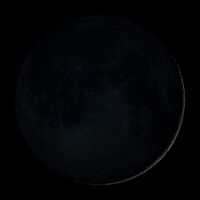 |
|
| Waxing crescent | Right side, (0%–50%) lit | Left side, (0%–50%) lit | Late morning to after sunset | 09:00 | 15:00 | 21:00 |
 |
 |
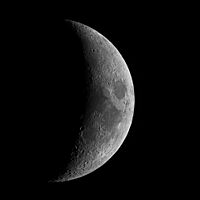 |
| First quarter | Right side, 50.1% lit | Left side, 50.1% lit | Afternoon and early night | 12:00 | 18:00 | 00:00 |
 |
 |
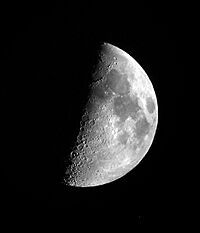 |
| Waxing gibbous | Right side, (50%–100%) lit | Left side, (50%–100%) lit | Late afternoon and most of night | 15:00 | 21:00 | 03:00 |
 |
 |
 |
| Full Moon |
|
Sunset to sunrise (all night) | 18:00 | 00:00 | 06:00 |
 |
 |
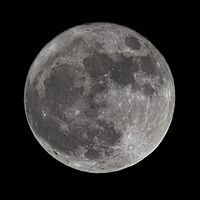 |
|
| Waning gibbous | Left side, (100%–50%) lit | Right side, (100%–50%) lit | Most of night and early morning | 21:00 | 03:00 | 09:00 |
 |
 |
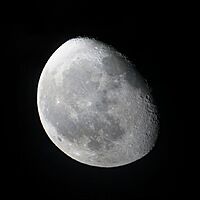 |
| Last quarter | Left side, 50.1% lit | Right side, 50.1% lit | Late night and morning | 00:00 | 06:00 | 12:00 |
 |
 |
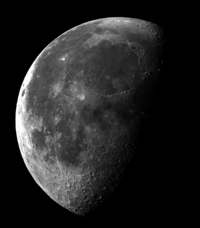 |
| Waning crescent | Left side, (50%–0%) lit | Right side, (50%–0%) lit | Before dawn to early afternoon | 03:00 | 09:00 | 15:00 |
 |
 |
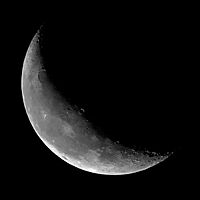 |
Waxing and Waning Explained
When the Sun and Moon are on the same side of Earth, we have a "new moon." At this point, the side of the Moon facing us is not lit by the Sun. As the Moon waxes (gets brighter), it goes through new moon, crescent moon, first-quarter moon, gibbous moon, and then full moon.
After the full moon, the Moon wanes (gets dimmer). It goes through gibbous moon, third-quarter moon, and crescent moon, before becoming a new moon again.
Sometimes people use "half moon" to mean the first- and third-quarter moons. The term "quarter" refers to how far along the Moon is in its journey around Earth, not its shape.
When the Moon is a crescent, you might see a faint glow on its dark side. This is called earthshine. It happens because sunlight reflects off Earth and then hits the Moon, making its dark side slightly visible. It's like "the old moon in the new moon's arms."
How the Moon Looks from Different Places
If you are in the Northern Hemisphere:
- If the left side of the Moon is dark, the bright part is growing. This means the Moon is waxing (getting closer to full).
- If the right side of the Moon is dark, the bright part is shrinking. This means the Moon is waning (getting closer to new).
So, in the Northern Hemisphere, the right side of the Moon is always the part that is growing brighter.
In the Southern Hemisphere, the Moon looks upside down compared to the Northern Hemisphere. So, the opposite sides appear to wax or wane.
Closer to the Equator, the line between the light and dark parts of the Moon (called the lunar terminator) can look more horizontal. This means the crescent Moon can appear to open upwards or downwards. When the Sun is below the horizon and the Moon is above the Sun, the crescent will open upwards. This is how it's often seen in tropical areas.
Earthshine
When the Moon is a thin crescent from Earth, Earth itself (as seen from the Moon) is almost fully lit by the Sun. This bright Earth reflects sunlight onto the Moon's dark side. This makes the dark part of the Moon faintly visible from Earth. This cool effect is called earthshine.
Moon Phases and Time
People have used the Moon's phases to keep track of time for thousands of years. The first sliver of a new moon was a clear sign to start a new month. Some calendars, like the Islamic calendar, are based entirely on the Moon's cycles.
However, a year of twelve lunar months is about ten or eleven days shorter than a solar year (Earth's orbit around the Sun). This means a lunar calendar would slowly get out of sync with the seasons. To fix this, some calendars, like the Chinese calendar, add an extra month every few years. This helps them stay aligned with both the Moon and the seasons.
The Roman calendar also used to follow the Moon. But Julius Caesar changed it to a solar calendar, which is the basis for the Gregorian calendar we mostly use today.
Calculating Moon Phases
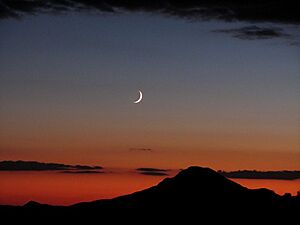
Each of the four in-between phases (like waxing crescent) lasts about seven days. The time from one new moon to the next is called a "lunation" or a "synodic month." Scientists can calculate the Moon's phase for any date by knowing how many days have passed since a known new moon.
Common Misunderstandings
Moon's Orbit vs. Phases
It can be confusing that the Moon takes about 27.3 days to orbit Earth, but its phases complete a cycle every 29.5 days. This difference happens because Earth is also moving around the Sun. So, the Moon has to travel a bit further to get back to the same position relative to both Earth and the Sun.
Eclipses Don't Happen Every Month
You might think that every new moon would cause a solar eclipse (when the Moon blocks the Sun) and every full moon would cause a lunar eclipse (when Earth's shadow falls on the Moon). But this doesn't happen every month.
Eclipses are rare because the Moon's orbit around Earth is tilted by about 5 degrees compared to Earth's orbit around the Sun. So, most of the time, the Moon is either a little above or a little below the direct line between Earth and the Sun during a new or full moon.
Eclipses only happen when the Moon is new or full AND it's also exactly in line with Earth and the Sun. This only occurs about twice a year, leading to between four and seven eclipses each year. Most of these are partial eclipses; total eclipses are even less common.
Phases Are Not Earth's Shadow
The Moon's phases are NOT caused by Earth's shadow falling on the Moon. The phases are caused by how much of the Moon's sunlit side we can see from Earth as the Moon orbits us. Earth's shadow only causes a lunar eclipse, which is a special event.
See also
 In Spanish: Fase lunar para niños
In Spanish: Fase lunar para niños
- Blue moon
- Earth phase
- Lunar month. (Also known as a "lunation".)
- Tide
- Week
- Month
Images for kids
-
A crescent Moon over Kingman, Arizona


